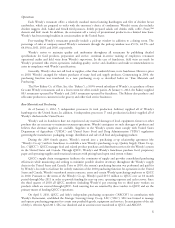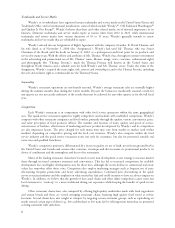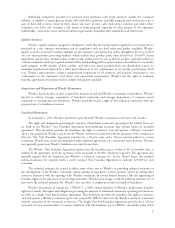Wendy's 2011 Annual Report Download - page 19
Download and view the complete annual report
Please find page 19 of the 2011 Wendy's annual report below. You can navigate through the pages in the report by either clicking on the pages listed below, or by using the keyword search tool below to find specific information within the annual report.restaurant sites were formerly gas stations or are adjacent to current or former gas stations, or were used for other
commercial activities that can create environmental impacts. We may also acquire or lease these types of sites in the
future. We have not conducted a comprehensive environmental review of all of our properties. We may not have
identified all of the potential environmental liabilities at our leased and owned properties, and any such liabilities
identified in the future could cause us to incur significant costs, including costs associated with litigation, fines or
clean-up responsibilities. In addition, we cannot predict what environmental legislation or regulations will be enacted
in the future or how existing or future laws or regulations will be administered or interpreted. We cannot predict the
amount of future expenditures that may be required in order to comply with any environmental laws or regulations or
to satisfy any such claims. See “Item 1. Business—General—Environmental and Other Matters.”
Wendy’s leases real property generally for initial terms of 20 years with two to four additional options to extend
the term of the leases in consecutive five-year increments. Many leases provide that the landlord may increase the rent
over the term of the lease and any renewals thereof. Most leases require us to pay all of the costs of insurance, taxes,
maintenance and utilities. We generally cannot cancel these leases. If an existing or future restaurant is not profitable,
and we decide to close it, we may nonetheless be committed to perform our obligations under the applicable lease
including, among other things, paying the base rent for the balance of the lease term. In addition, as each lease
expires, we may fail to negotiate additional renewals or renewal options, either on commercially acceptable terms or at
all, which could cause us to close stores in desirable locations.
Due to the concentration of Wendy’s restaurants in particular geographic regions, our business results could be
impacted by the adverse economic conditions prevailing in those regions regardless of the state of the national
economy as a whole.
As of January 1, 2012, we and our franchisees operated Wendy’s restaurants in 50 states, the District of
Columbia and 27 foreign countries and territories. As of January 1, 2012 as detailed in “Item 2. Properties,” the 8
leading states by number of operating units were: Florida, Ohio, Texas, Georgia, Michigan, California, Pennsylvania
and North Carolina. This geographic concentration can cause economic conditions in particular areas of the country
to have a disproportionate impact on our overall results of operations. It is possible that adverse economic conditions
in states or regions that contain a high concentration of Wendy’s restaurants could have a material adverse impact on
our results of operations in the future.
Our operations are influenced by adverse weather conditions.
Weather, which is unpredictable, can impact Wendy’s restaurant sales. Harsh weather conditions that keep
customers from dining out result in lost opportunities for our restaurants. A heavy snowstorm in the Northeast or
Midwest or a hurricane in the Southeast can shut down an entire metropolitan area, resulting in a reduction in sales in
that area. Our first quarter includes winter months and historically has a lower level of sales at company-owned
restaurants. Because a significant portion of our restaurant operating costs is fixed or semi-fixed in nature, the loss of
sales during these periods hurts our operating margins, and can result in restaurant operating losses. For these reasons,
a quarter-to-quarter comparison may not be a good indication of Wendy’s performance or how it may perform in the
future.
Wendy’s business could be hurt by increased labor costs or labor shortages.
Labor is a primary component in the cost of operating our company-owned restaurants. Wendy’s devotes
significant resources to recruiting and training its managers and hourly employees. Increased labor costs due to
competition, increased minimum wage or employee benefits costs (including government-mandated health care
benefits) or other factors would adversely impact our cost of sales and operating expenses. In addition, Wendy’s
success depends on its ability to attract, motivate and retain qualified employees, including restaurant managers and
staff. If the brand is unable to do so, our results of operations could be adversely affected.
Wendy’s plans to expand its breakfast initiative. The breakfast daypart remains competitive and markets may
prove difficult to penetrate.
The breakfast initiative at Wendy’s has been accompanied by challenging competitive conditions, varied
consumer tastes and discretionary spending patterns that differ from lunch, snack, dinner and late night hours. In
addition, breakfast sales can cannibalize sales during other parts of the day and may have negative impacts on food
and labor costs, advertising, and restaurant margins. Wendy’s plans to expand its breakfast initiative. Capital
15
























